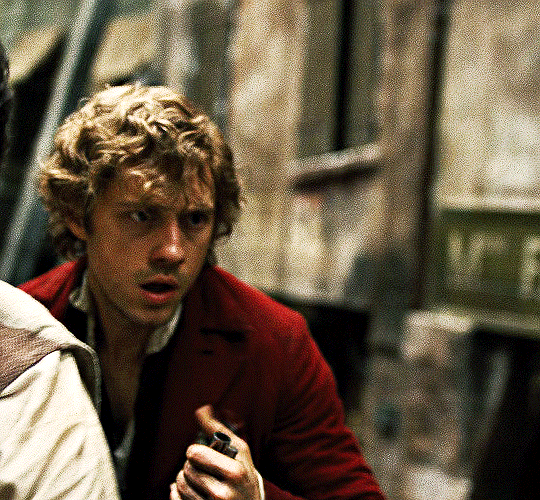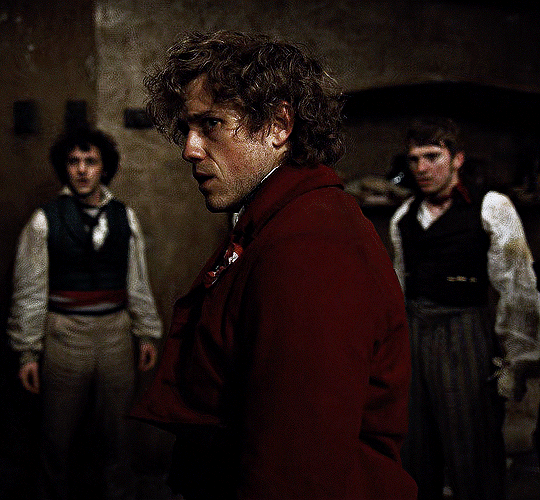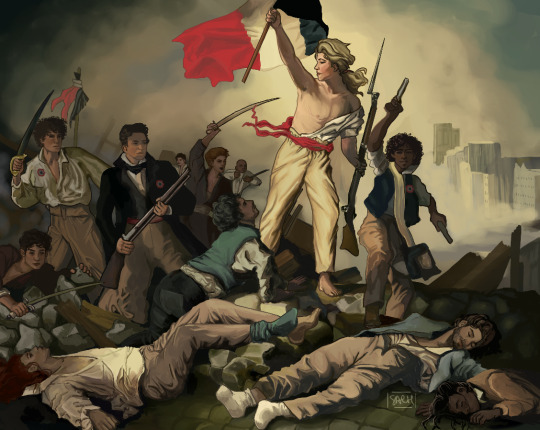#the barricades
Note
Hello! I am catching up on les mis letters and I think the October 7(???) chapter mentions that none of the les amis are wearing ties. Can you tell me the significance of this? I know nothing of FRev ✌️
Sure! I assume you mean this line:
They reached the Quai Morland. Cravatless, hatless, breathless, soaked by the rain, with lightning in their eyes.
A quick Obligatory Mention that Les Mis is not set in the French Revolution, but in the post-Republic years of the early 19C ! Which is of course mostly relevant here because instead of imagining a bunch of sans culottes

(1842 black and white art of two sans culottes, rather pretty and idealized, by Emilé Wattier)

( a color picture of a sans culotte on the left and maybe far right, with a culottes-wearing drummer between them. All are wearing phrygian caps and republic cockades, and seem to be going off to fight together)
You're instead looking at a group more like this, Fashionwise:

Révolution de 1830 - Combat devant l'hôtel de ville , an idealized portrayal of revolutionaries in 1830, fighting outside the Hotel de VIlle, by Jean-Victor Schnetz (you can really zoom in on it at the Wiki page!)
I wanted to bring that--again, highly idealized -- pic of 1830 in because it shows not just what people were wearing, more or less, but how that was being socially interpreted!
You've got a lot of different hats here--top hat, workers' caps, bandanas, soldier's hats, etc. And IDK how much you know about fashion in this era, Nonny, but I bet you can start picking out a pattern to who's wearing what.
Especially the way that cravatlass people in workers' caps and bandanas and Phrygian caps are, by and large, turned away from the camera, or have their faces in shadow, while the composition leads us to a central, heroic figure--a student-type in obvious Fashionably Respectable clothes, with a great big cravat. There's even an older man in a nice top hat, with a saber, looking and gesturing to him! THIS is our Central Guy, a good bourgeois type the presumed viewer can feel safe with! Even the heroic worker (hat apparently missing, but he's in overalls, then as now a garment linked with labor) who's swooning into the central student's arms has his eyes shadowed , though at least we see most of his face.
You could write a whole paper on this painting alone, but the barebones relevance here: a bourgeois audience is going to have very different reactions to people who are visibly of Their Class than the scaaaaary, faceless Working Class. And in the real world where combat and crowds aren't as neat and shiny as this painting and the little details like shoes and socks and fit of the trousers and so on is going to get lost in the dust and distance, one of the easiest ways to read a man's social status is hats and cravats -- who's wearing them , what sort are they wearing, etc.
So on an immediate, practical, level , losing the hats and cravats is a bit like "rolling up your sleeves"-- ditching or loosening restrictive clothing before doing hard physical work. But on a social/symbolic level, it's a way of erasing differences of status and social standing between the barricade fighters. Hats gone, cravats gone, everyone soaked by rain and covered in mud, there's no easy distinction between Enjolras and Feuilly--or between a porter and a poet.
Which is all very egalitarian and symbolic and all--but to the sort of reader/ viewer who the painting up there is targeting, it's also very scary, because now there's no obvious sympathetic "leader", no easily-spotted reassuring figure to make them think it's all being organized by the Right Sort of people. It's just a scary,lower-class, undifferentiated mob.
Both these factors, the symbolic equality and the perceived mob nature of the uprising, are very relevant to the rebellion in Les Mis!
..and also it's just SUPER awkward to try and do hard physical work with a tight binding loop of fabric around your throat, or without losing most hats. The Struggle is Real, there.
#what do I even tag this#uh#The Barricades#fashion on the barricades#this was a GOOD QUESTION Nonny sorry if it is kind of a Lot of Answer XD
69 notes
·
View notes
Text
"Kill them with kindness" WRONG. To the barricades! 🪑🪑🪜⚰️🪑💥🚪⚰️🪑🪜⚰️🚪🪑⚰️💥⚰️🪑⚰️🪑🪜🪑💥⚰️🪜🪑⚰️🪑🚪🪑⚰️🪑💥⚰️🚪🪑⚰️🪑🪑⚰️💥🪑⚰️⚰️🪑🪜⚰️🪑💥🚪🪑⚰️🪑⚰️🪜💥🚪🪑⚰️⚰️🪑💥🪜⚰️🪑🪑⚰️🪜
#finding barricade related emojis was the most difficult part of taking part in this meme#les miserables#enjolras#les amis de l'abc#kill them with kindness#les mis#les amis#not screenreader friendly#didn't even occur to me to add that before! sorry!
6K notes
·
View notes
Text
It's that time of the year again! Remember to leave out bread and absinthe for Victor Hugo and he will leave you 50 pages on a subject that is off-topic but that he is vaguely interested in. Be safe out there!
4K notes
·
View notes
Text
hey sorry we put your boyfriends in a perpetual time loop. yeah they're fated to die tragically in a doomed rebellion on 5-6th june every year. sorry.
4K notes
·
View notes
Photo










AARON TVEIT as Enjolras
LES MISÉRABLES (2012) dir. Tom Hooper
#les miserables#les mis#aaron tveit#enjolras#filmedit#aarontveitedit#lesmiserablesedit#lesmisedit#movieedit#enjolrasedit#musicaledit#barricade day#*#well ofc i had to make this for today
3K notes
·
View notes
Text
3K notes
·
View notes
Text

I started this for last year's Barricade Day then forgot about it and finished it about a month ago
Happy Barricade Day 2023 everyone! I guess I'm never growing out of this
#sach art#les mis#les miserables#les amis#les amis de l'abc#enjolras#grantaire#bahorel#feuilly#courfeyrac#combeferre#joly#bossuet#marius pontmercy#eponine thenardier#jehan prouvaire#barricade day#enjoltaire#exr
3K notes
·
View notes
Text
When the best fandom reunites to celebrate a non-official holiday based on a revolution mentioned in a 200-year-old novel

#barricade day#classic literature#les miserables#les mis#victor hugo#enjoltaire#enjolras#les amis de l'abc#happy barricade day#i love this yearly event with all my heart#btw ik the revolution was real
3K notes
·
View notes
Text

ta-da!!!
#giorno giovanna#jjba#jjba part 5#vento aureo#he does this in headspace semi regularly#Barricades’ art
2K notes
·
View notes
Text

#otome#otome game#otome fandom#shall we date#shall we date otome#obey me#obey me shall we date#ikemen series#ikemen vampire#mystic messenger#code: realize#code realize#collar x malice#cupid parasite#variable barricade#café enchanté#cafe enchante#hakuoki#norn9#uta no prince sama#diabolik lovers#amnesia#piofiore#I was reincarnated as the villainess#ouran high school host club#fruits basket#idea factory#personal
5K notes
·
View notes
Text

Jean Valjean pls bring Les amis home too🥺
#les mis#les miserables#barricade boys#enjolras#combeferre#courfeyrac#feuilly#jolllly#jehan prouvaire#bahorel#bossuet#grantaire#gavroche#eponine#jean valjean#javert
832 notes
·
View notes
Text
I love how Les Mis (the original novel) is so fundamentally hopeful about the power of rebellion and activism. So many adaptations/retellings of Les Mis imply its message is kinda shallow and defeatist— something about how rebellion never changes anything/always puts you back right where you began, so it’s wiser to never stand against the government. But that’s not the novel at all.
The original novel, which Hugo wrote as a barely-veiled call to action against the government of Napoleon III, is so convinced of the value of resistance against tyranny. The message is not that resistance is doomed to fail— it is that resistance to an unjust government is imperative, and it will be a moral victory even if the resistance is crushed.
The June rebellion in Les mis May have been repressed, and it may have failed in its goal of overthrowing the monarchy— but later rebellions did eventually succeed. France doesn’t have a monarchy anymore. A democracy is now in place, the way the rebels of 1832 would’ve wanted. There’s an undercurrent of hope throughout Les Mis— it’s not a story about how rebellion/resistance is futile, it’s a story about how it’s necessary, and about how positive social change is not only possible but also inevitable.
#les mis#barricade day#people really act like Les mis is a tale of two cities#which does have the shallow xec
2K notes
·
View notes
Text

2K notes
·
View notes
Text
Other fandoms: celebrate their characters' birthdays
Les Mis fandom: celebrate their characters' massacre
2K notes
·
View notes
Text

ID : a tweet from the Siecle history podcast that reads "Some of the most detailed historical research being done today about 19th Century France is done by a small community of fans trying to make their fanfiction historically accurate."
1K notes
·
View notes